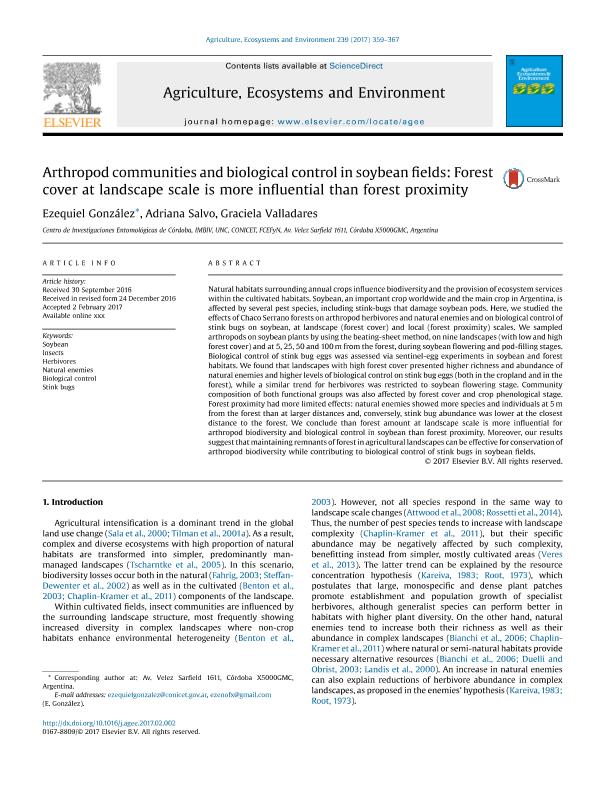Artículo
Arthropod communities and biological control in soybean fields: Forest cover at landscape scale is more influential than forest proximity
Fecha de publicación:
15/02/2017
Editorial:
Elsevier Science
Revista:
Agriculture, Ecosystems and Environment
ISSN:
0167-8809
Idioma:
Inglés
Tipo de recurso:
Artículo publicado
Clasificación temática:
Resumen
Natural habitats surrounding annual crops influence biodiversity and the provision of ecosystem services within the cultivated habitats. Soybean, an important crop worldwide and the main crop in Argentina, is affected by several pest species, including stink-bugs that damage soybean pods. Here, we studied the effects of Chaco Serrano forests on arthropod herbivores and natural enemies and on biological control of stink bugs on soybean, at landscape (forest cover) and local (forest proximity) scales. We sampled arthropods on soybean plants by using the beating-sheet method, on nine landscapes (with low and high forest cover) and at 5, 25, 50 and 100m from the forest, during soybean flowering and pod-filling stages. Biological control of stink bug eggs was assessed via sentinel-egg experiments in soybean and forest habitats. We found that landscapes with high forest cover presented higher richness and abundance of natural enemies and higher levels of biological control on stink bug eggs (both in the cropland and in the forest), while a similar trend for herbivores was restricted to soybean flowering stage. Community composition of both functional groups was also affected by forest cover and crop phenological stage. Forest proximity had more limited effects: natural enemies showed more species and individuals at 5m from the forest than at larger distances and, conversely, stink bug abundance was lower at the closest distance to the forest. We conclude than forest amount at landscape scale is more influential for arthropod biodiversity and biological control in soybean than forest proximity. Moreover, these results suggest that maintaining remnants of forest in these agricultural landscapes can be effective for conservation of arthropod biodiversity while contributing to biological control of stink bugs in soybean fields.
Palabras clave:
Soybean
,
Insects
,
Herbivores
,
Natural Enemies
,
Biological Control
,
Stink Bugs
Archivos asociados
Licencia
Identificadores
Colecciones
Articulos(IMBIV)
Articulos de INST.MULTIDISCIPL.DE BIOLOGIA VEGETAL (P)
Articulos de INST.MULTIDISCIPL.DE BIOLOGIA VEGETAL (P)
Citación
González, Ezequiel; Salvo, Silvia Adriana; Valladares, Graciela Rosa; Arthropod communities and biological control in soybean fields: Forest cover at landscape scale is more influential than forest proximity; Elsevier Science; Agriculture, Ecosystems and Environment; 239; 15-2-2017; 359-367
Compartir
Altmétricas




